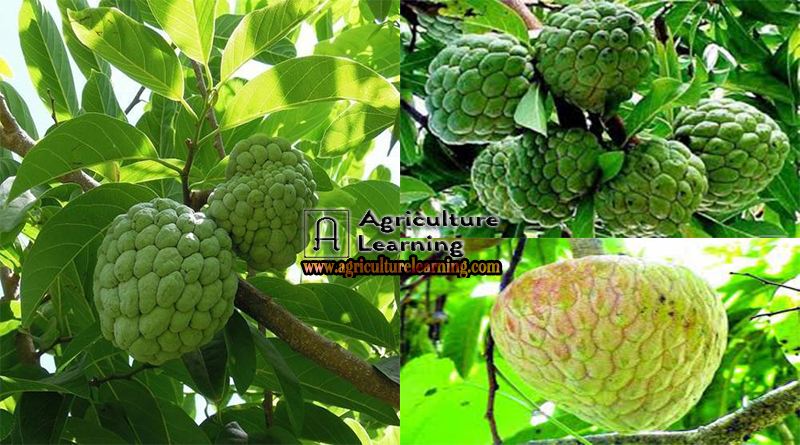Custard apple production Technology and it’s health benefits
Custard apple (Annona squamosal) also known as sharifa in Bangladesh is a delicious dry land fruit. The fruits are low in Saturated fat, Cholesterol and Sodium and high in Vitamin C, Manganese, Iron and Potassium. The custard apple are mainly growing in tropical parts of America, Australia, Brazil, Egypt and some parts of India.
Soil and Climate condition for Sharifa or custard apple:
- It is a tropical plant but can also be grown in mild sub-tropics also.
- It is sensitive to frost.
- Custard apple (sharifa) flourished best in the dry and hot climate.
- It requires light soil and is generally grown on the slope of hills.
- The plants are raised from seeds and bear fruit in about 3 to 4 years.
- The plant flowers from april to May and bears fruit between August and November.
- The major climate factors limiting commercial production of custard apple are temperature and humidity.
- It can withstand high rainfall or drought and is tolerant to many soil conditions except alkalinity.
Varieties of Custard Apple:
- Annona squamosal: (custard apple, sugar apple, sweetsop)
- Annona cherimola: ( lakshmanphal cherimoya)
- Annona reticulate: (bullocks heart, ram phal)
- Annona muricata: ( sour soap, mundla sitaphal)
- Annona diversifolia: ( ilama)
Propagation and Root stick:
- Propagation is generally done through seeds.
- Seeds are sown directly into the fields in well prepared pits in beginning of monsoon and at appropriate height and girth.
- Propagation by budding and whip grafting has been successful for improving the yield and quality.
Planting:
- Pits of (60 x 60 x 60) cm size are made in summer refilled with soil and FYM (1:1).
- Planting distance is kept at (4.5 x 4.5) m to (5.0 x 5.0) m.
- Planting is done at the beginning of monsoon to avail the advantage of available rain water.
Manuring and Fertilization:
| Age of tree (Years) | FYM (kg/plant) | Fertilizer (Gram/tree) | ||
| Urea | Diammonium Phosphate | Muriate of potash | ||
| 1-2 | 25 | 120 | 109 | 84 |
| 3-5 | 35 | 240 | 217 | 167 |
| Above 5 | 50 | 252 | 271 | 209 |
Irrigation:
- It doesn’t require irrigation to produce fairly good crop provided effective water harvesting is affected by developing micro-catchments in rainy season.
- Moreover, in absence of water harvesting in post monsoon period 2-3 irrigations help in better quality of fruits and higher production.
Flowering:
- Takes about 3 years for plants to come into bearing and 5 or more years to develop full canopy.
- An average plant bears about 2000 flowers and the fruit set is about 2-3%.
- Fruit set is better where humidity is high.
Harvesting and yield:
- Custard apple yields twice a year in a tree.
- It comes into bearing from the age of 4-5 years.
- The fruit ripen within 3-4 months from the time of flowering.
- It is a climacteric fruit and should be and should be harvested when fully matured and firm.
Nutrient value of custard apple (100 g):
| Nutrient | Amount |
| Protein | 5.2 g |
| Water | – |
| ash | 1.9 g |
| Calories total | 235 |
| Carbohydrate cals | 213 |
| Fat calories | 6.1 |
| Protein calories | 17 |
| Total carbohydrate | 59 g |
| Dietary fiber | 11 g |
| Total fat | 725 mg |
| Saturated fat | 120 mg |
| Mono-saturated fat | 285 mg |
| Poly unsaturated fat | 100 mg |
| Omega-6 fatty acids | 100 mg |
| Vitamin A | 15 I.V. |
| Vitamin C | 91 mg |
| Thiamine | 275 mcg |
| Riboflavin | 283 mcg |
| Niacin | 2.2 mg |
| Vitamin B6 | 500 mcg |
| Folate | 35 mcg |
| Pantothenic acid | 565 mcg |
| calcium | 60 mg |
| Iron | 105 mg |
| Magnesium | 53 mg |
| Phosphorus | 80 mg |
| Potassium | 618 mg |
| sodium | 23 mg |
| Zinc | 250 mcg |
| Copper | 215 mcg |
| selenium | 1.5 mcg |
Health benefits:
- Relaxing muscles and protecting heart against diseases
- Helps to grow weight
- Replenish energy levels
- Useful in ulcer, abscesses and boils
- For a better brain health
- For a better immune system
- For a strong dental system
- Natural anti-cancerous properties
- Resistant to infectious diseases
- For a better vision
- Lower the risk of Arthritis
- Good for fetal skin and hair
- For a better cardiovascular health
- Good for better fetal brain development
- Natural antidote for morning sickness
- Good for skin rejuvenation
- Naturally heals the skin infections
- Keeps skin cancer away
- Good for pimple prone skin
- Natural detoxifying agent
- Helps to eliminate lice
- For better hair growth
- Lowers pigmentation problems
- Natural antidote for scalp infections
- For a luxurious moisturized hair
Diseases and their management:
Symptoms: fruit rot
Dry, blackish-brown spots the blossom end of the fruit which spread slowly in all directions and usually cover whole fruit.
Management:
The disease can be effectively controlled by foliar sprays with copper oxychloride (300g/100L) water, carbendazim (100g/100L) water or thiophanate methy1(100g/100L) water, giving 2-3 sprays at 15 days interval.





I am extremely impressed with your writing skills and also with
the layout on your weblog. Is this a paid theme or
did you customize it yourself? Anyway keep up the nice quality writing, it’s rare to ssee
a great blog like this one today.
my website :: https://penzu.com/p/6bb0260c